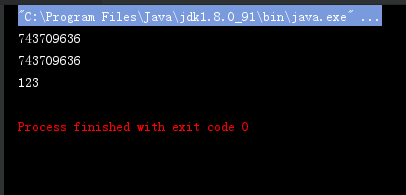很久之前看了一篇半吊子文章,理解错了。去参加了个面试,跟别人滔滔不绝的讲了半天,结果回来一查,错了,好尴尬!辣鸡害人不浅。现在我就总结一下,踩过的坑,含着泪也要填了。先来看下面试官怎么问的。
为什么要重写hashCode()和equals()?
其实我们平时用的多的就是集合里的对象判断是否相等。比如说HashMap中put一个键值对,看它的底层方法实现:
public V put(K key, V value) {
return putVal(hash(key), key, value, false, true);
}我们看到方法里调用了一个hash函数,具体实现如下:
static final int hash(Object key) {
int h;
return (key == null) ? 0 : (h = key.hashCode()) ^ (h >>> 16);
}可以看到它没有直接用key的hash值,而是跟默认数组长度取了个模。我们知道,随机的hashCode碰撞的概率很小。我们通过取模的方式,让每个值都能均匀的存放在链表上。
言归正传,虽然put是对象的hashCode跟一个数取模,但是我们来看看HashMap是怎么来取值的。
/*
*判断
*/
public boolean containsKey(Object key) {
return getNode(hash(key), key) != null;
}
/*
*根据key取值
*/
public V get(Object key) {
Node<K,V> e;
return (e = getNode(hash(key), key)) == null ? null : e.value;
}
/*
*根据key remove
*/
public V remove(Object key) {
Node<K,V> e;
return (e = removeNode(hash(key), key, null, false, true)) == null ?
null : e.value;
}我们看到它们都用到了上面提到的hash()方法。
然而当我们要定义一个对象作为HashMap的key的时候,如果我们不在这个对象内重写hashCode()和equals()的话,他们都会用父类的hashCode()和equals()。也就是Object的。而Object的hashCode()返回的是对象在内存中的地址。equals()也是比较的是两个对象的堆上的地址是否相同,也就是说是不是同一块内存。就是说比较的是他们是不是他们自己。下面举个栗子:
定义一个对象Student,没有重写hashCode()和equals()
@Getter
@Setter
@ToString
public class Student {
private Double sn;
private String name;
private String className;
public Student(double sn, String name, String className) {
this.sn = sn;
this.name = name;
this.className = className;
}
}然后,我们new这个对象,放到HashMap中然后,再:
public class TestDemo {
public static void main(String[] args) {
Map<Student, Integer> urlMap = new HashMap<>();
Student student1 = new Student(12345,"simon","class_2");
System.out.println(student1.hashCode());
urlMap.put(student1, 123);
Student student2 = new Student(12345,"simon","class_2");
System.out.println(student2.hashCode());
System.out.println(urlMap.get(student2));
}
}打印出的结果是:

两串数字就是两个对象的地址。我们调用的hashCode()和equals()也是Object的方法
因为对象是放在堆上的,每次new就是一个新的内存空间,而每一块内存空间都有一个自己的地址。
只重写hashCode()不重写equals()可以吗?
@Override
public int hashCode() {
int result = 17;
result = result * 31 + sn.hashCode();
result = result * 31 + name.hashCode();
result = result * 31 + className.hashCode();
return result;
}
我们发现HashCode一样了,但还是返回null,到底为什么呢?我们来看看,get方法是如何实现的:
public V get(Object key) {
Node<K,V> e;
return (e = getNode(hash(key), key)) == null ? null : e.value;
}
/**
* Implements Map.get and related methods
*
* @param hash hash for key
* @param key the key
* @return the node, or null if none
*/
final Node<K,V> getNode(int hash, Object key) {
Node<K,V>[] tab; Node<K,V> first, e; int n; K k;
if ((tab = table) != null && (n = tab.length) > 0 &&
(first = tab[(n - 1) & hash]) != null) {
if (first.hash == hash && // always check first node
((k = first.key) == key || (key != null && key.equals(k))))
return first;
if ((e = first.next) != null) {
if (first instanceof TreeNode)
return ((TreeNode<K,V>)first).getTreeNode(hash, key);
do {
if (e.hash == hash &&
((k = e.key) == key || (key != null && key.equals(k))))
return e;
} while ((e = e.next) != null);
}
}
return null;
}流程大概是:
- 先根据key的HashCode跟数组长度取余得到特殊的Hash值,
- 确定数组中元素的位置,然后根据算出的特殊hash值获取链表首节点,
- 遍历链表寻找有没有相同的 key,判断依据是 e.hash == hash && ((k = e.key) == key || key.equals(k))
由于没有重写equals(),此处的key.equals(k)比较的是我们传入对象的地址,和之前put进当前节点的key对象的地址。所以没有匹配的值。所以轮询完毕后最终返回null
重写equals()
@Override
public boolean equals(Object o) {
if (this == o)
return true;
if (o == null)
return false;
if (getClass() != o.getClass())
return false;
Student student = (Student) o;
if (name == null) {
if (student.name != null)
return false;
} else if (!name.equals(student.name))
return false;
if (className == null) {
if (student.className != null)
return false;
} else if (!className.equals(student.className))
return false;
if (sn == null) {
if (student.sn != null)
return false;
} else if (!sn.equals(student.sn))
return false;
return true;
}运行结果:


重写了equals()就必须重写hashCode()?
是因为我们要做的是两个对象的比较,如果不重写hashCode(),我们连集合内对象都找不到,还怎么去比较他们的内容。
























 4601
4601











 被折叠的 条评论
为什么被折叠?
被折叠的 条评论
为什么被折叠?








